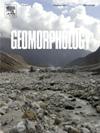使用机器学习的滑坡易感性分析:来自罗马尼亚喀尔巴阡山脉下弯的见解
IF 3.1
2区 地球科学
Q2 GEOGRAPHY, PHYSICAL
引用次数: 0
摘要
该研究提出了一个使用最大熵(MaxEnt)机器学习算法的滑坡易感性图。为此,在弯下喀尔巴阡山脉和喀尔巴阡山脉(罗马尼亚)选择了376平方公里的面积。在该地区,根据高分辨率航空图像和实地调查,绘制了966个滑坡地图。在GIS环境中建立了一个中等分辨率的包含地质因素(岩性单位、地层年龄、坡度、形态结构单位和土地利用)的数据库。结果表明,岩性和坡度是与滑坡空间分布最相关的因素。滑坡易感性图(滑坡发生概率)与由西南向东北发育的岩性构造单元有很好的重叠。采用受试者工作特征(ROC)曲线评价模型的性能。结果值0.82表明预测精度很高,与其他侧重于滑坡易感性评估的研究报告的值相当。在此基础上,根据岩性-构造单元划分出了2个高概率带和2个低概率带。本文章由计算机程序翻译,如有差异,请以英文原文为准。
Landslide susceptibility analysis using machine learning: Insights from the bend Subcarpathians-Carpathians, Romania
The study presents a landslide susceptibility map using maximum entropy (MaxEnt) a Machine Learning algorithm. For this purpose, an area of 376 km2 was selected in the Bend Subcarpathians and Carpathians (Romania). In this area, 966 landslides were mapped based on high-resolution aerial imagery and field surveys. A database containing geo-factors (lithological units, age of formations, slope, morpho-structural units, and land use) at medium resolution was built in a GIS environment. The results show that lithology and slope are the factors that best correlate with the spatial distribution of landslides. The landslide susceptibility map (probability of landslide occurrence) overlaps very well with the litho-structural units developed from southwest to northeast. The model's performance was evaluated using the Receiver Operating Characteristic (ROC) curve. The resulting value of 0.82 indicates a high level of predictive accuracy, comparable to values reported in other studies focused on landslide susceptibility assessment. Based on the results, four susceptibility zones (two high probability, two low probability) have been highlighted according to the litho-structural units.
求助全文
通过发布文献求助,成功后即可免费获取论文全文。
去求助
来源期刊

Geomorphology
地学-地球科学综合
CiteScore
8.00
自引率
10.30%
发文量
309
审稿时长
3.4 months
期刊介绍:
Our journal''s scope includes geomorphic themes of: tectonics and regional structure; glacial processes and landforms; fluvial sequences, Quaternary environmental change and dating; fluvial processes and landforms; mass movement, slopes and periglacial processes; hillslopes and soil erosion; weathering, karst and soils; aeolian processes and landforms, coastal dunes and arid environments; coastal and marine processes, estuaries and lakes; modelling, theoretical and quantitative geomorphology; DEM, GIS and remote sensing methods and applications; hazards, applied and planetary geomorphology; and volcanics.
 求助内容:
求助内容: 应助结果提醒方式:
应助结果提醒方式:


